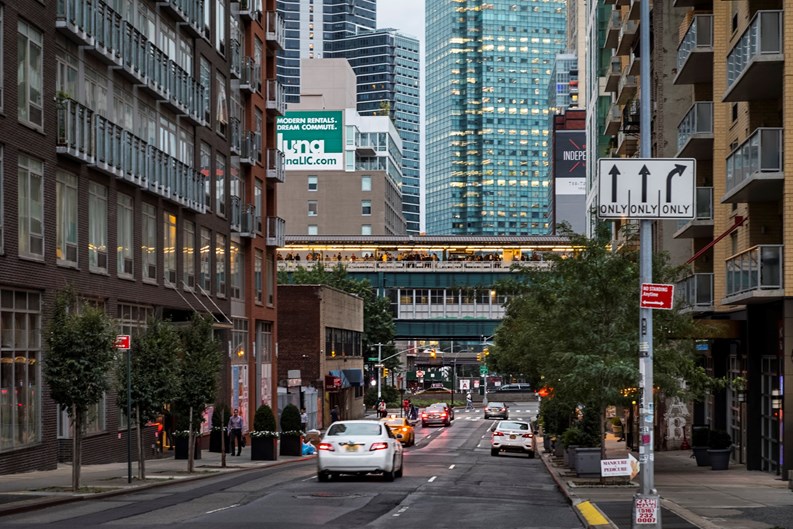New York City has always had a rotating cast of neighborhoods-of-the moment – buzzed-about areas where the hottest bars and restaurants, the coolest attractions, burgeoning businesses, and alluring residential properties all seem to cluster.
One of those neighborhoods is Long Island City in Queens. Last September, The Wall Street Journal turned an eye toward the area’s condo scene (specifically The Harrison at 22-21 44th Drive, a 27-story building with a gym, lounge, children's room, and rooftop access), and observed that while sales in the area bottomed out in 2011 in the wake of the financial crisis, things are looking up. That said, much of the heat surrounding these brisk purchases can be attributed to a limited supply of units in the neighborhood, as much of the residential stock is still comprised of rentals.
So what should the enthusiastic market spectator think of Long Island City? The Cooperator spoke with several real estate professionals with strong ties to the area to discuss the finer points of the neighborhood, its condo scene, and its future.
A Neighborhood Anew
Over the past few decades, Long Island City has come a long way from its industrial roots, and few have observed its transition more closely than Brian Dusseau, a real estate agent with brokerage firm Halstead who not only works in the neighborhood but lived there from 1996 until 2015.
“[Long Island City] is a brand new neighborhood in the sense that it has changed due to rezoning from light industry to residential,” says Dusseau. “But you certainly still have the townhomes and walk-ups that have been there forever, along with iconic Italian restaurants like Manetta's, and families that have been there from the ‘70s or earlier.
"But otherwise, demographically," he adds, "the neighborhood is brand new. It's not as if you have the same mix of old-world and new high-rises; there's no dominant culture that is being displaced, like you'd have in Astoria where it is predominantly Greek, or Greenpoint where it had long been a Polish neighborhood. In Long Island City, you're only displacing industry. So it's kind of refreshing.”
Gregory Cohen, CEO of Impact Real Estate Management, which opened its doors in Long Island City in 1997, has had a similar vantage from which to remark upon the demographic shift. “It's all young millennials moving in now, or married couples either without kids or with small children,” he notes. “But, as the children start to grow into school age, they start moving out.”
Dusseau has not only noted this latter point but lived it. “What Long Island City does not have enough of, and which I'd really like to see, is larger three-bedroom-and-up developments,” he says. “Families like mine grow to a certain size, and sometimes we're faced with moving because we don't have those bigger apartments.”
That said, for those not contending with urban child rearing, Long Island City has a vibrant restaurant culture, a striking waterfront with breathtaking views of the city, a burgeoning comedy scene, and a landmark rock-climbing gym. What it may need more of, however, and as Cohen notes, is more functional commercial services. “They're just starting to put in dry cleaners; they're only now getting supermarkets in the neighborhood,” he says. “They don't even have a hospital in the area.”
Lack of hospital aside, a dearth of commercial offerings may not inhibit younger residents as much in an era of Blue Apron and FreshDirect. “When I first started in real estate, I was selling a project in Brooklyn, and everyone was complaining how there wouldn't be a supermarket nearby,” recalls Elizabeth Ann Stribling-Kivlan, President of brokerage firm Stribling & Associates. “But I don't think that's the way it is anymore. Everything is available on the internet. Maybe dry cleaning could be an issue, but that could be offered as an in-building amenity. With Uber and the rise of consumer goods delivery services, it's not as important to have that stuff nearby.
“And in regard to the people who I know are moving out there...it's a really open demographic,” Stribling-Kivlan continues. “I have friends with young kids, friends who are single, friends in relationships who are all heading to Long Island City. Some work in education, retail, or non-profits...they're seeing that there's a real bang for their buck, and that counts for a lot.”
A Renter's Market?
From a condo standpoint, would-be buyers may need to have some patience.
“Most of the current residential and construction – all of the high-rises that you see – are rentals,” notes Cohen. “There are small condominiums being built – 20- or 30-unit buildings, but for the most part, they're rentals. And the rents are often as high as those in Manhattan. So builders are reluctant to sell when they can get top-dollar in rents. I think that as the rental market becomes more saturated, you'll start to see more condominiums. Or you'll see buildings that were being built as rentals convert to condos. That I could possibly see.”
“Of something like 9,000 units entering the market in the next year, most are rentals,” agrees Dusseau. “And that market will take time to fill up. But I find that people who rent in Long Island City fall in love with the area and want to buy. There's just not a ton of inventory as of yet. All of the new condos are small and unique.”
Among the Long Island City residential properties that do currently offer condo life, Dusseau is excited about Arris Lofts, Powerhouse, and Galerie, which offer an array of amenities like gyms, pools, saunas, and steam rooms.
“The best value I think, long-term, is in Citylights, the condop,” he says. “It's the only condop in the neighborhood, but it's suffering right now, as it's the first property to deal with the tax abatement ending. So we're dealing with maintenance going up precipitously due to that situation. But I think that if people are bullish on Long Island City long-term, and they want somewhere they're going to live for another six to 10 years, then they can find some real bargains in the Citylights building. It's going to be a buyer's market for the next couple of years, and once the condos come out of the tax abatement, it should be ahead of the curve.”
Anybody who has ridden a Queens-bound N, W or 7 train of late can tell by the abundance of massive construction projects flanking Queensboro Plaza that the area is on the literal rise. While the eventual distribution of residential between rental and condo/co-op property remains to be seen, the amount of money and effort currently being invested in Long Island City indicates that a lot of major real estate players see it as a neighborhood with a bright future.
“I think that, for a long time, Queens was a misunderstood borough,” says Stribling-Kivlan. “A lot of people put Queens down, while in reality, it has such incredible diversity, such incredible restaurants. And to get the best views of the city, you have to leave Manhattan and turn around. And Long Island City is what's exciting right now.”
Stribling-Kivlan compares Long Island City to Hudson Yards, another emerging area in the Big Apple. “I know a lot of people who were sharing apartments, and are moving out to Long Island City to live alone," she says. "And I think that the more people that do that, the more they will want to build condos out there. It's a tail-wagging-the-dog type situation.”
Mike Odenthal is a staff writer at The Cooperator.







Leave a Comment